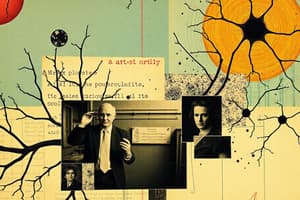Podcast
Questions and Answers
What is the action resulting from no sense according to the content?
What is the action resulting from no sense according to the content?
Depolarization
Can a stimulus being less than required lead to an action potential?
Can a stimulus being less than required lead to an action potential?
False (B)
What happens when a subthreshold stimulus arrives?
What happens when a subthreshold stimulus arrives?
- An action potential is generated
- No action potential occurs (correct)
- The stimulus spreads
- Distance changes
Less stimulus than required means ____ at threshold.
Less stimulus than required means ____ at threshold.
What can be concluded about the size of the action potential based on distance?
What can be concluded about the size of the action potential based on distance?
What occurs when a stimulus is below the threshold required for action potential?
What occurs when a stimulus is below the threshold required for action potential?
A subthreshold stimulus can still cause an action potential if additional stimuli are applied.
A subthreshold stimulus can still cause an action potential if additional stimuli are applied.
What is the term for the phenomenon when a stimulus fails to produce an action potential?
What is the term for the phenomenon when a stimulus fails to produce an action potential?
If the stimulus is too weak, it results in ____ at threshold.
If the stimulus is too weak, it results in ____ at threshold.
Match the following terms with their correct definitions:
Match the following terms with their correct definitions:
Flashcards are hidden until you start studying
Study Notes
Neuron Activation and Action Potential
- Neurons undergo depolarization and repolarization during the generation of action potentials (AP).
- Depolarization occurs when the internal voltage of a neuron becomes less negative, potentially leading to an AP.
- Repolarization follows, restoring the negative internal charge of the neuron.
Action Potential Threshold
- A specific threshold must be reached for an action potential to occur.
- If the stimulus is subthreshold, no action potential is generated, indicating a threshold level is crucial for neuronic response.
- The required stimulus must exceed a critical level to propagates an AP.
Stimulus Magnitude and Spread
- Insufficient stimulus strength results in no action potential.
- The spread of the action potential does not change with distance but propagates at a consistent rate.
- Larger stimuli do not lead to larger action potentials; instead, action potentials are all-or-nothing events.
Summary of Key Concepts
- Subthreshold stimuli yield no action potential, demonstrating the importance of adequate stimulus strength.
- Potential changes are not additive; a slightly greater stimulus will not produce a larger response.
- Neurons maintain consistent action potential sizes regardless of variations in stimuli, which leads to uniform signaling.
Neuron Activation and Action Potential
- Neurons undergo depolarization and repolarization during the generation of action potentials (AP).
- Depolarization occurs when the internal voltage of a neuron becomes less negative, potentially leading to an AP.
- Repolarization follows, restoring the negative internal charge of the neuron.
Action Potential Threshold
- A specific threshold must be reached for an action potential to occur.
- If the stimulus is subthreshold, no action potential is generated, indicating a threshold level is crucial for neuronic response.
- The required stimulus must exceed a critical level to propagates an AP.
Stimulus Magnitude and Spread
- Insufficient stimulus strength results in no action potential.
- The spread of the action potential does not change with distance but propagates at a consistent rate.
- Larger stimuli do not lead to larger action potentials; instead, action potentials are all-or-nothing events.
Summary of Key Concepts
- Subthreshold stimuli yield no action potential, demonstrating the importance of adequate stimulus strength.
- Potential changes are not additive; a slightly greater stimulus will not produce a larger response.
- Neurons maintain consistent action potential sizes regardless of variations in stimuli, which leads to uniform signaling.
Studying That Suits You
Use AI to generate personalized quizzes and flashcards to suit your learning preferences.




